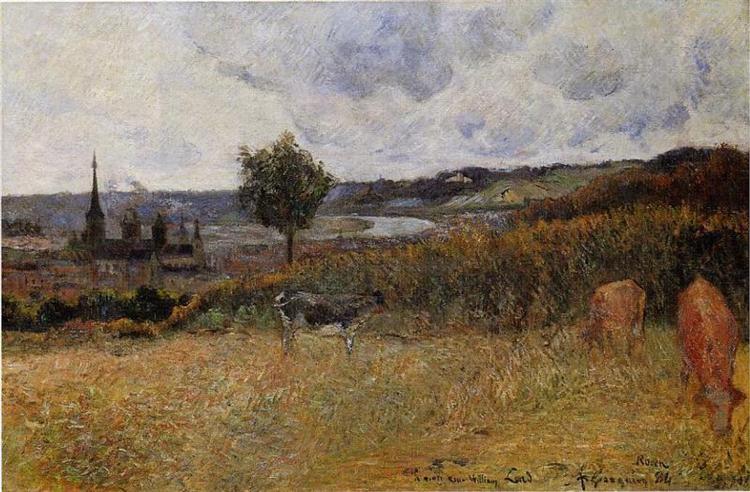Description
The painting "near Ruan - 1884" by Paul Gauguin is a work that, although it may not be as recognized as some of its most emblematic pieces, offers a penetrating look on Gauguin's artistic evolution and its relationship with the Norman landscape. In this painting, Gauguin captures the essence of the French countryside, but does so through a prism that combines naturalistic observation with a more symbolic and emotional approach.
The landscape, for the most part, presents exuberant vegetation, with lush green tones that are displayed through the canvas, creating a sensation of vitality and growth. This color use is characteristic of the period in which Gauguin began to explore the chromatic vivacity that would mark his career. The compositional structure reveals a careful balance between heaven and earth, with a sky that unfolds in a palette of soft blue and pasty clouds that add a feeling of depth and space. This blue background contrasts with the vibrant and yellow green that dominate the foreground, achieving a visual dialogue that invites the viewer to enter the scene.
Unlike other works of his time, where human figures often dominated space, "near Ruan" shows greater attention to the interaction between the natural and the human, although there are no prominent characters on the scene. However, the presence of a small structure, probably a cabin or farm, hints the existence of human life in the environment, suggesting a link between man and its landscape. This choice can be seen as a reference to rural life and the social context of the time, where Gauguin contemplated the relationship between the natural and the everyday.
The technique of energetic brushstroke and the rich texture that characterizes this work reveals the influence of impressionism, but with Gauguin's distinctive turn towards a more abstract use of colors. Thus, the artist moves away from the precise detail of impressionism, seeking instead of symbolism that would become a distinctive seal of his subsequent work. This work, therefore, can be seen as a transition towards its exploration of symbolism and the use of color as a vehicle of emotions beyond mere representation.
In the historical context, "near Ruan" is part of a period in which Gauguin was in a constant search for his own voice, exploring various themes and styles that would eventually lead him to his expatriation in Tahití. This painting It occurs at a time when the artist began to question not only the technique, but also the meaning of art itself, and how it can represent and evoke deep human emotions through nature.
Thus, "near Ruan - 1884" it is not simply a landscape; It is a work that encapsulates Gauguin for redefining his art, reimagining his place within the European visual universe. Although more subtle in its expressiveness than some of his subsequent works, this painting It offers a window to the evolutionary state of an artist who was, without a doubt, on the threshold of a new era in his creative practice. In each line and nuance, Gauguin invites the viewer to feel more than to see, to contemplate the beauty of the natural world through a personal and transformative perspective.
KUADROS ©, a famous paint on your wall.
Hand-made oil painting reproductions, with the quality of professional artists and the distinctive seal of KUADROS ©.
Reproduction service paintings With a guarantee of satisfaction. If you are not completely satisfied with the replica of your painting, we refund your money 100%.

